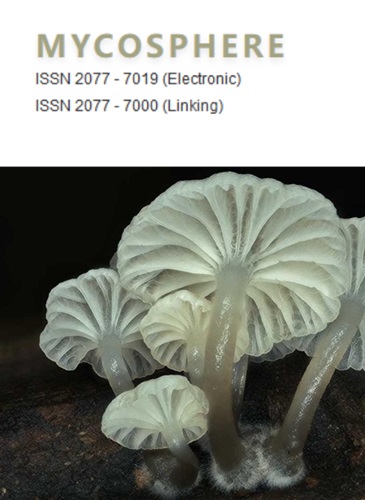Preliminary classification of Leotiomycetes
IF 15.1
1区 生物学
Q1 MYCOLOGY
引用次数: 49
Abstract
Leotiomycetes is regarded as the inoperculate class of discomycetes within the phylum Ascomycota. Taxa are mainly characterized by asci with a simple pore blueing in Melzer’s reagent, although some taxa have lost this character. The monophyly of this class has been verified in several recent molecular studies. However, circumscription of the orders, families and generic level delimitation are still unsettled. This paper provides a modified backbone tree for the class Leotiomycetes based on phylogenetic analysis of combined ITS, LSU, SSU, TEF, and RPB2 loci. In the phylogenetic analysis, Leotiomycetes separates into 19 clades, which can be recognized as orders and order-level clades. Leotiomycetes include 53 families (Ascodichaenaceae, Amicodiscaceae fam. nov., Amorphothecaceae, Arachnopezizaceae, Ascocorticiaceae, Calloriaceae, Cenangiaceae, Chaetomellaceae, Chlorociboriaceae, Chlorospleniaceae fam. nov., Bryoglossaceae fam. nov., Cochlearomycetaceae, Cordieritidaceae, Cyttariaceae, Deltopyxidaceae fam. nov., Dermateaceae, Discinellaceae fam. nov., Drepanopezizaceae, Erysiphaceae, Gelatinodiscaceae, Godroniaceae, Hamatocanthoscyphaceae fam. nov., Helicogoniaceae, Helotiaceae, Hemiphacidiaceae, Heterosphaeriaceae, Hyaloscyphaceae, Hydrocinaceae fam. nov., Hyphodiscaceae fam. nov., Lachnaceae, Lahmiaceae, Lauriomycetaceae, Leotiaceae, Leptodontidiaceae, Lichinodiaceae, Loramycetaceae, Marthamycetaceae, Medeolariaceae, Mitrulaceae, Mollisiaceae, Neocrinulaceae, Neolauriomycetaceae, Pezizellaceae, Phacidiaceae, Ploettnerulaceae, Rhytismataceae, Rutstroemiaceae, Sclerotiniaceae, Solenopeziaceae fam. nov., Thelebolaceae, Triblidiaceae, Tympanidaceae and Vibrisseaceae) and 14 family-level clades (Alatospora-Miniancora clade, Aquapoterium-Unguicularia clade, Bulgariella clade, ColeophomaParafabraea clade, Colipila clade, Corticifraga-Calloriopsis clade, Epicladonia-Epithamnolia clade, Flagellospora clade, Gelatinomyces clade, Micraspis clade, Patellariopsis clade, Phialocephala urceolata clade, Peltigeromyces clade and Trizodia clade). We briefly discuss the phylogenetic placements of these families and family-level clades. We provide an outline of the genera and the families of Leotiomycetes and a table summarising sexual morph characters of all Mycosphere 10(1): 310–489 (2019) www.mycosphere.org ISSN 2077 7019毛菌的初步分类
绒毛菌被认为是子囊菌门中不带壳的硬菌纲。分类群的主要特征是在梅尔泽试剂中有一个简单的孔蓝,尽管有些分类群已经失去了这个特征。这类植物的单系性已在最近的几项分子研究中得到证实。但是,目、科的划分和属级的划分仍未解决。本文基于ITS、LSU、SSU、TEF和RPB2基因座的系统发育分析,构建了一棵改良的利多菌纲主干树。在系统发育分析中,利多菌分为19个支系,可分为目系和目级支系。利多菌包括53科(球囊菌科、amicodisaceae)。11、无定形科、蜘蛛科、球囊科、花椒科、Cenangiaceae、毛茛科、绿球藻科、绿球藻科。11月,bryoglossaceaceae;11月,耳蜗菌科,堇青藤科,胞菌科,三角霉菌科。11月,皮科,蕨科。11月,龙葵科,丹参科,明胶科,龙葵科,金丝桃科。11、螺蛳科、螺蛳科、半果皮科、杂交种科、透明丝瓜科、水螅科等。11月,丝瓜科。nov., Lachnaceae, Lahmiaceae, Lauriomycetaceae, Leotiaceae, Leptodontidiaceae, Lichinodiaceae, Loramycetaceae, Marthamycetaceae, Medeolariaceae, Mitrulaceae, Mollisiaceae, Neocrinulaceae, Neolauriomycetaceae, Pezizellaceae, Phacidiaceae, Ploettnerulaceae, Rhytismataceae, Rutstroemiaceae, sclerotinaceae, Solenopeziaceae。11 .(11 .),龙舌兰科,三叶草科,鼓室科和vibrisaceae)和14个科级分支(alatosporia - miniancora分支,aquapoteria - unguicularia分支,Bulgariella分支,ColeophomaParafabraea分支,Colipila分支,Corticifraga-Calloriopsis分支,epicladoniia -上皮分支,鞭毛孢子分支,Gelatinomyces分支,Micraspis分支,Patellariopsis分支,Phialocephala urceolata分支,Peltigeromyces分支和Trizodia分支)。我们简要地讨论了这些科和科级进化枝的系统发育位置。我们提供了一个利多菌属和科的概要,并总结了所有真菌球10(1):310-489 (2019)www.mycosphere.org ISSN 2077 7019的性别形态特征表
本文章由计算机程序翻译,如有差异,请以英文原文为准。
求助全文
约1分钟内获得全文
求助全文
来源期刊

Mycosphere
MYCOLOGY-
CiteScore
30.00
自引率
8.20%
发文量
9
审稿时长
4 weeks
期刊介绍:
Mycosphere stands as an international, peer-reviewed journal committed to the rapid dissemination of high-quality papers on fungal biology. Embracing an open-access approach, Mycosphere serves as a dedicated platform for the mycology community, ensuring swift publication of their valuable contributions. All submitted manuscripts undergo a thorough peer-review process before acceptance, with authors retaining copyright.
Key highlights of Mycosphere's publication include:
- Peer-reviewed manuscripts and monographs
- Open access, fostering accessibility and dissemination of knowledge
- Swift turnaround, facilitating timely sharing of research findings
- For information regarding open access charges, refer to the instructions for authors
- Special volumes, offering a platform for thematic collections and focused contributions.
Mycosphere is dedicated to promoting the accessibility and advancement of fungal biology through its inclusive and efficient publishing process.
 求助内容:
求助内容: 应助结果提醒方式:
应助结果提醒方式:


